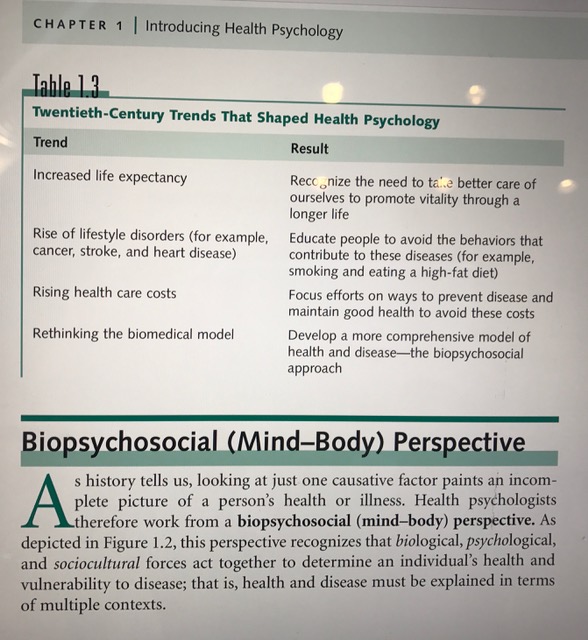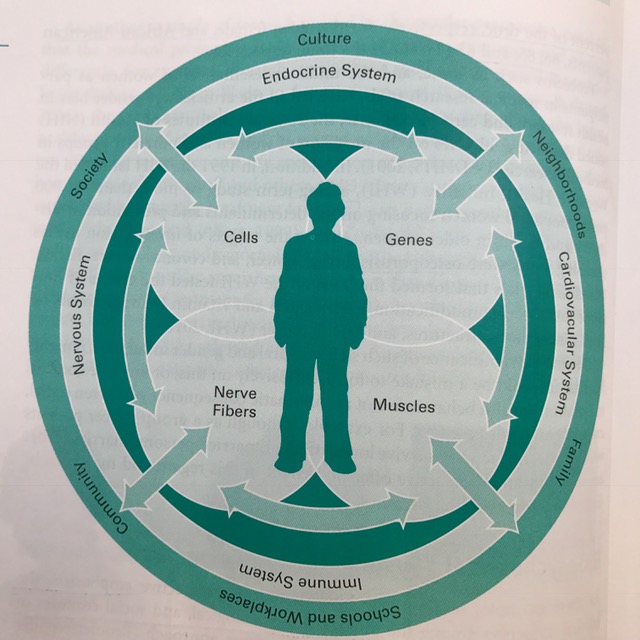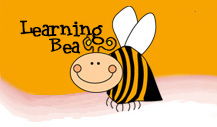

learningbea.org copyright 2016.
Talks about what we understand as "health" ( which is the absence of disease) but explains how this is somehow incomplete.
It concludes that health involves physical as well as psychological and social well being.
Health Psychology:
The application of psychological principles and research to the enhacement of health and te prevention and treatment of illness.
Health:
A state of complete Physical, mental ans social well-being.
Health and Illness: Lessons form the past.
Prehistoric times; illness cause by evil spirits and treated by shamans and sometime treated by Trephination: ( europe, Egypt, India, Central & South America)
An ancient medical intervention in which a hole was drilled into the human skull, presumably to allow "evil spirits" to scape. ( 4000 yeasr ago it was descovered that hygene also played a role and cleansing rituals appeared all through the ancient world. Egypt & Mesopotamia manufactured bathing facilities.
Ancient Greece & Ancient Rome: illness cause by inbalance of bodily humors. " good diet and moderatate living would be the cure; as well as "pathogenes" such as bad air and body humors, were the causes of illness and the remedies were: enemas and baths. In rome the most dramatic advances in public health and sanitation were made during the 6th and 5th centuries.
Hippocrates ( 460 - 377 BCE0 stablished the roots of Western medicine. He rebelled against the ancient focus on supertition and mysticism. Often called the "father of modern medicine" was the first to argue that disease is a natural phenomenon and that the causes of disease are knowable, and worthy of serious study.
Claude Galen Born in Greece, live mostly in Rome where he treated gladiadors and developed his medical career. ( 129 - 200 C,E) Wrote about anatomy, hygenebuilding up on Hippocratic foundations of rational explanations and careful description of each patients' Physical symptoms.
Middle Ages: ( 476- 14500) Disease was divine punishment for sins, cures by miraculous intervention, invoking of saints, as well as bloodletting.
Renaissance: In the fifteen century the reemergence of scientific inquiry , this period saw the revitalization of anatomical study and medical practice. the taboo on human disection was lifted and in enough that Flemish anatomist Andreas Vesalius published a seven volume study of the internal organs, musculature and skeletal system.
Disease was a physical condition of the body which was separate from the mind. Surgical techniques were first used at this time.
The thoughts of philosopher René Descartes who was the first to refer to the human body as " a machine" . Also he is best known for his beliefs that the mind and body are autonomous processes that interact minimally, and that each is subject to different laws of casualty. this is a principle called The mind-body dualism aka Cartes
This era ushered a new age of medical research base on confidence in science an rational thinking
It created a lasting bias in Western medicine against the importance of psychological processes in health
Epidemic: disease that spreads rapidly among many individuas in a community. at the same time.
Pandemic: Disease affects people over a large geographical area.
Post Renaissance Rationality: Focus basically on biological causes ( leaving behind the humoral theories form the Hippocrates. Science and medicine changed rapidly during the XVII ) XVIII centuries due to advances in technology. The most important invention of this time : the microscope.
Fashioned by a dutch merchant ( part time scientist) Anton van Leeuwenhoek ( 1632-1725).
He was the first observer of blood cells and the structure of skeletal muscles.
The microscope helped scientists to developed new theories about the origins of disease.
Anatomical Theory: Scientists should focus on the anatomical causes of diseases.
Cellular theory: Disease results when body cells malfunction or die.
Germ theory: Viruses, bacyeria and other microorganisms that invade the body are the cause of diseases.
Louis Pasteur ( 1822-1895) besides hi famous work with vaccination. Pasteur set the stage fo he later development of aseptics ( germ-free) surgicak pricedures.
William Morton ( 1819 -1868) American dentist introduced the gas ether as anesthesic.
Wilhelm Roentgen (1845-n1943) German physicist discovered X rays .
By the enf of the 18th century:
Researchers had identified the microorganisms that caused malaria, pneumonia, diptheria, syphilis, Typoid. Finally science was able to bring under control diseases that had plagued the world since antiquity.
Biomedical model: Illness has a biological cause. This line of thought continues to represent the dominant view in modern medicine up to this day. embraces Reductivism: the view that complex phenomena derive ultimately from a single primary factor.
Pathogen: virus, bacteria or any other microorganism the invades the body.
Psychosomatic medicine: Even though the biomedical mode;l had advanced significantly, was still unable to explain disorders that had no observable physical cause such as those uncovered by Sigmund Freud: ( 1956 - 1939) initially trained as a physician, his patients exhibited symptoms such as: deafness, lost of speech and even paralysis.
Note: although Freud's theories and psychosomatic medicine were flawed, they laid groundwork for a renewed appreciation of the connection s between medicine and psychology. This was the start of the contemporary viewing of illness and health as multifactorial.
Instead of thinking illness is caused by a single factor, the new thought is that disease is caused by many different types of factors:
Host factors ( such as exposure to polllutants and hazzardous materials) Behavioral factors( diet, exercise, smoking) and Physchological factors ( such as optimism and overal "hardiness"
Freud believed these maladies were caused by unconscious emotional conflicts that had been " converted" into physycal form.
Psychosomatic Medicine:outdated branch of medicine focused on the diagnosis and tratment of Physical diseases caused by faulty psychological processes.
Behavioral medicine: interdisciplinary fields that integrates behavioral and biomedical science in preventing, diagnosing and treating illness. In the eraly 70s behavioral medicine began to explore the role of learned behaviors in health and disease.
Neal Miller ( 1902-1970) who used operant conditoning techniques to teach lab animals to gain control over certain bolily functions. Miller demostrated among other things that people could gain control over their blood pressure and resting heart rate called (Biofeedback).
The emergence of Health Psychology:
IN 1973 the American Psychological Association ( APA) appointed the task to explore Psychology role in the field of behavioral medicine and in 1978 APA creatyed the division of Heath Psychology..
its mission is:
1) To study scientifically the causes and origins of specifics diseases that is, their etiology.
2) To promote health. Health psychologists consider ways to get people to engage in health-enhancing behaviors. ( exercising regularly and and following balanced diets)
3) To prevent and treat illness. They design programs to help people stop addictive behaviors such as: smoking , weight loss, stress management and to minimize other risk factors for poor health.
4) To promote public heath policy and the improvement of health care system. they are active in health education and the creation of goverment health policies.
Intro to Health Psychology. Chapter 1
Heath Disparities:
Preventable differences in he burden of disease, injury, violence or opportunities to achieve optimal health that are experienced by socially disadvantaged populations.

Interesting data about heath disparities:
+ death rates vary by etnic group.
Between American men & women, those of European ancestry have a longer life expectancy thann African- Amenricans.
+ Americans have a shorteh life expectancy than people in Japan, Canada, Australia, The UK, Italy , France .
( sensus 2012)
+ An estimated 1 million deaths each year in the USA ( among all age groups) are preventable, see table 1.1
( below)
+ Although men are twice as likely to die of any cause than women, beginning in middle age, women have higher disease & disabilities rates.
Health Psychology

Biopsychosocial Perspective
According to Biopsychosocial perspective. all heath behaviors are best explained in terms of three contexts:
Biological processes
Psychological processes
and social influences.
Biopsychosocial =
Genomics: The study of the genome.
Genome: Complete genetic instructions that makes a living organism.
Epigenics:The effects of enviornmental forces on how genes are expressed.
LIfe-Course Perspectives: Theoretical perspective that focus on the age-related aspects that affects our health and causes illness.
Subjective wellbeign: The cognitive and emotional evaluation of a person's life.
Psychological Context: Basically it pertains to how well the person copes with a stressful life.
Social Context: as the word suggests it is the envirionment circunstances surrounding the person.
Birth Cohort: A group pf people that because they were born at about the same time, experience similar historical and social conditions.
Socialcultural Perspectives:The view point that it is impossible to understand a person fully without understanding his ot her culture and ethnic identity.
Gender Perspectives: a focus on geneder specific health behaviors, problems and barriers to health.
Biopsychological Systems
Ecological-Systems Approach: Nature is best understood as a hierarchy of systems. Each system is composed of smaller subsystems and larger inter-related systems.
So, for example: It’s the end of the year, and Mr. John-Doe is tense, because he has to take care of lots of financial wrap-ups, and PR materials (stressful stuff, that tenses his muscles, and raises his heart rate & blood pressure) so inevitably, these variables affect his immunologic system. What does Mr. John-Doe, do to contrarest the negative effects these stressful activities? Mr. John-Doe combines: ”the boring” (a.k.a stressful) with “the fun”!
That is, he looks for strategies (activities) within his outer systems -- social & cultural -- (family/friends), hobbies & activities that fit his sociocultural traditions (such as the development of next-year calendars ), as “end-of-the-year-gifts” to his love ones. This activity involves searching among hundreds of photos of happy memories that trigger the release of endorphins, that in time, puts him at ease, relaxing his tensed muscles, hence, helping lowering his blood pressure. His outer systems (family & friends in turn benefit themselves when they feel included and taken into account which creates a chain-boomerang-reaction in which both parties; the giver and the receiver of gifts feel acknowledged and loved, incrementing the success ratio of this particular Ecological-System-Approach to health.
Applying the biopsychosocial model: It is best understood as ocurring in 3 contexts: Biological, Social and cultural context.
Book example: Marianne:A 20 year old college sophomore female student that presents to her family doctor, with a bad headache, shortness of breath, sleeplessness, a racing heart and a wild frighten expression. Applying the "Ecological-System Approach to Health", would suggest that the systems influencing Mariana's headache, shortness of breath, etc, includes her body's internal biology systems
(immune, endocrine , cardiovascular, and nervous) as well as her neighborhood, culture, and other external systems of which she is part of. See graph below:

Example:
Marianne: A 20 year old college sophomore female student that presents to her family doctor,
Symptoms:
a bad headache, shortness of breath, sleeplessness, a racing heart and a wild frighten expression.
the "Ecological-System Approach to Health", would suggest that the systems influencing her includes her body's internal biology systems.
(immune, endocrine , cardiovascular, and nervous) as well as her neighborhood, culture, and other external systems of which she is part of.

